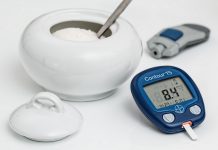
The meat exchanges are divided into three categories: lean, medium fat and high fat. All meat groups have the same amount of protein, which is seven grams. The calorie content varies from 55 calories for lean meats and 75 calories for medium fat to 100 calories for high-fat meats. The caloric difference between meats is their fat content. Lean meats have only 3 grams of fat, medium fat meats have 5 grams and high-fat meats have 8 grams of fat. So, the higher the fat content in the high-fat meats is what increases the calories. Fat is the most calorie concentrated nutrient at nine calories per gram.
To limit your intake of saturated fats and cholesterol, choose mostly lean meats and medium fat meats (skinless poultry and turkey, round steak, fish, lean ground beef – at least 90% lean, cottage cheese, loin pork chops, low-fat cheeses such as mozzarella). Limit high-fat meats such as bacon (pork or turkey), ground pork, hot dogs (beef, pork, turkey or chicken), sausages, spareribs, sandwich meat, cold cuts and regular cheese to infrequent choices.
The American Diabetes Association’s recommended guidelines for people with diabetes include a low saturated fat, low cholesterol eating plan. This is because people with diabetes develop more cholesterol deposits (atherosclerosis) in their arteries and at a younger age than people who don’t have diabetes. The cause of this increased rate of atherosclerosis is unknown, but higher sugar or insulin levels in the blood may be the reason.



